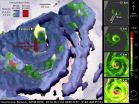NASA's GPM satellite's find before Hurricane Simon was caught rapidly intensifying
2014-10-08
(Press-News.org) Hurricane Simon appeared to be keeping a secret before it rapidly intensified on Oct. 4, but the Global Precipitation Measurement or GPM satellite was able uncover it.
On Oct. 4 at 0940 UTC (5:40 a.m. EDT) observations by the Ku-band radar on the GPM satellite suggested that the Eastern Pacific Ocean's Hurricane Simon was hiding a very compact eyewall hours before the National Hurricane Center detected rapid intensification of Simon's surface winds. The GPM satellite was launched in February of this year and is managed by both NASA and the Japan Aerospace Exploration Agency.
"This eyewall, a hollow ring of intense storms, had a diameter too small to be detected by other satellite instruments or with real time wind analyses that blend together such satellite observations," said Owen Kelley of NASA's Goddard Space Flight Center in Greenbelt, Maryland. Kelley analyzed the GPM data. "The intense convective cells (small, intense, short-lived rainstorms) that sometimes occur in compact eyewalls are known to be able to cause rapid intensification of hurricanes, but such small features are only easy to detect with radar." That basically means radar-equipped aircraft or the GPM satellite must fly over the storm.
The NOAA P-3 aircraft did fly through Hurricane Simon on Oct. 4, but only after the National Hurricane Center determined that rapid intensification had already occurred.
In the coming years, GPM will enable scientists to study such unusual meteorological situations and may improve our understanding of hurricanes and of other kinds of severe storms. The GPM satellite will collect observations from a vast, but intermittent, sample of interesting meteorological situations, such as Hurricane Simon. The GPM satellite will collect observations from the Arctic to the Antarctic circles and everything in between over the next three years, and perhaps longer. GPM will see features of the world's weather that otherwise might remain undetected.
At 5 a.m. EDT (2 a.m. PDT) on Oct. 4 the National Hurricane Center reported that Hurricane Simon was unable to form an eyewall that completely circled the eye because of a gap on the northeast side. Operational wind analyses that may have guided this statement were done at 11 p.m. on Oct. 3 and 3 a.m. PDT on Oct. 4. Those analyses showed a radius of maximum wind that was moderately large, 47 to 52 km (29 to 43 miles).
At 2:40 a.m. PDT, the GPM satellite saw that Hurricane Simon had a very compact eyewall. The eyewall had a radius of merely 10 km (6.2 miles) and hid a powerful convective cell. "The convective rain cell contained a 45 dBZ radar-reflectivity signal that reached 6.4 km (3.9 miles) altitude which is unusually high for such a strong signal in a hurricane eyewall," Kelley said.
Compact eyewalls can increase the chance of rapid intensification because there is so little air trapped in the eye of the hurricane. The small volume of air in a small eye is easier to heat with the energy released when rain forms in the eyewall. Ultimately, this energy lowers the surface air pressure under the eye, and in response, the circling winds speed up at the ocean's surface.
At 8 a.m. PDT, the National Hurricane Center reported that rapid intensification had occurred and that a small eye was visible. At 10:20 a.m. PDT the NOAA P-3 aircraft flew through Hurricane Simon and reported that the maximum winds were 10 km away from the center of the eye, which suggests that the very compact eyewall that GPM had observed at 2:40 a.m. had persisted and may have been Hurricane Simon's primary eyewall (the region of maximum wind speed) throughout this period.
This aircraft overflight was the first time that the NOAA P-3 had flown through Hurricane Simon, making the GPM overflight earlier that day the only prior radar "fix" on Hurricane Simon's "heat engine," its eyewall and eye. A detailed analysis would be needed to figure out how all of these observations illuminate Hurricane Simon's rapid intensification.
INFORMATION:
GPM data courtesy of NASA and JAXA. For more information, visit: http://www.nasa.gov/gpm
[Attachments] See images for this press release:

ELSE PRESS RELEASES FROM THIS DATE:
2014-10-08
A new study from the University of Utah confirms that substantial numbers of teens are sexting – sending and receiving explicit sexual images via cellphone. Though the behavior is widely studied, the potentially serious consequences of the practice led the researchers to more accurately measure how frequently teens are choosing to put themselves at risk in this fashion.
The study surveyed 1,130 undergraduate students about their experiences sexting in high school. Nearly 20 percent reported they had sent a nude photo of themselves to another via cellphone and 38 ...
2014-10-08
Two NASA satellites provided data on clouds, rainfall and the diameter of the eye of Super Typhoon Vongfong as it turned north in the Northwestern Pacific Ocean.
Typhoon Vongfong formed on October 2, 2014 southeast of Guam. Typhoon Phanfone, that recently pummeled Japan, formed near the same area in the western Pacific Ocean.
Vongfong had wind speeds of about 120 knots (138 mph) when the Tropical Rainfall Measuring Mission or TRMM satellite flew above the intensifying typhoon's eye on October 7, 2014 at 0800 UTC (4 a.m. EDT). TRMM's Precipitation Radar (PR) showed that ...
2014-10-08
WASHINGTON, DC – October 8, 2014 - Elephants are among the most intelligent non-humans, arguably on par with chimps, but both African and Asian elephants—separate species—are endangered. In 1995, 16-month old Kumari, the first Asian elephant born at the National Zoo in Washington, DC, died of a then-mysterious illness. In 1999, Gary Hayward of Johns Hopkins University and collaborators published their results identifying a novel herpesvirus, EEHV1 as the cause of Kumari's sudden death. They now show that severe cases like this one are caused by viruses ...
2014-10-08
ST. LOUIS, MO – OCTOBER 8, 2014 – What could the natural diversity and beauty of plant leaves have in common with one of mankind's greatest creative inventions, the violin? Much more than you might imagine.
"There are many parallels between leaves and violins," says Dan Chitwood, Ph.D., assistant member, Donald Danforth Plant Science Center in St. Louis, Missouri. "Both have beautiful shapes that are potentially functional, change over time, or result from mimicry. Shape is information that can tell us a story. Just as evolutionary changes in leaf shape inform ...
2014-10-08
Gamma rays are the highest-energy form of radioactive waves known in the universe. However, how they're made and where they come from have been a bit of a mystery.
But now a team of researchers, led by Michigan State University astronomer Laura Chomiuk, has made a discovery that may shed some light on the subject.
Using highly detailed radio telescope images, Chomiuk and her team have pinpointed the location where an explosion on the surface of a star, known as a nova, emitted gamma rays.
This, said Chomiuk, is something they did not expect to encounter.
"We not ...
2014-10-08
In western society, where keeping up with the Joneses — or, better yet, surpassing them — is expected and even encouraged, status matters. So important is it that for many people, physical and emotional wellbeing are directly connected to their place in the social hierarchy.
That's hardly news to anthropologists at UC Santa Barbara, but they were taken by surprise when research findings indicated that the same relationship exists among the Tsimane, an egalitarian society of forager-farmers in the Bolivian Amazon. Their work is published online in the journal ...
2014-10-08
The Northern Indian Ocean has awakened after a tropical slumber and created Tropical Storm Hudhud on Oct. 8 and NASA's Aqua satellite passed overhead.
The Atmospheric Infrared Sounder or AIRS instrument that flies aboard NASA's Aqua satellite passed over Tropical Cyclone Hudhud on Oct. 8 at 6:53 UTC (2:53 a.m. EDT and captured infrared data on the storm revealing bands of strong thunderstorms around the center.
Animated infrared satellite imagery showed that the low-level circulation center was consolidating, and there is an improvement in the banding of thunderstorms ...
2014-10-08
TORONTO, October 7, 2014 – Health technology company Infonaut, a MaRS client, has released a study showing that hospital patients may be at significant risk of infection due to their own poor hand hygiene. The findings were measured in a Toronto hospital using Infonaut's Hospital Watch Live™ system, innovative technology designed to assist hospitals in monitoring and controlling the spread of infections by analyzing the movement and behaviour of hospital staff, patients and equipment.
The study found that patients on average washed their hands only 30% of the time ...
2014-10-08
Researchers at Children's Hospital Los Angeles (CHLA) have described for the first time a specific perceptual learning deficit in mice with a mutation of the same gene as found in children with Fragile X Syndrome (FXS). Their findings, published on October 8 by PLOS ONE, may offer an effective pre-clinical platform for both investigating how brain circuitry is altered in FXS and testing drugs to improve these symptoms in children.
FXS is the most common inherited form of mental impairment, affecting an estimated 1 in 4,000 males and 1 in 6,000 females. Symptoms include ...
2014-10-08
Four families likely influenced violin shape over four centuries, with many imitating famous designs like Stradivarius, according to a study published October 8, 2014 in the open-access journal PLOS ONE by Daniel Chitwood from Donald Danforth Plant Science Center in Missouri.
The first violins appeared in 16th century Italy and since then, their designers have continued to incorporate numerous innovations to improve the acoustical properties and playability of violins. However, details of the body outline can vary without significantly compromising sound quality and may ...
LAST 30 PRESS RELEASES:
[Press-News.org] NASA's GPM satellite's find before Hurricane Simon was caught rapidly intensifying







